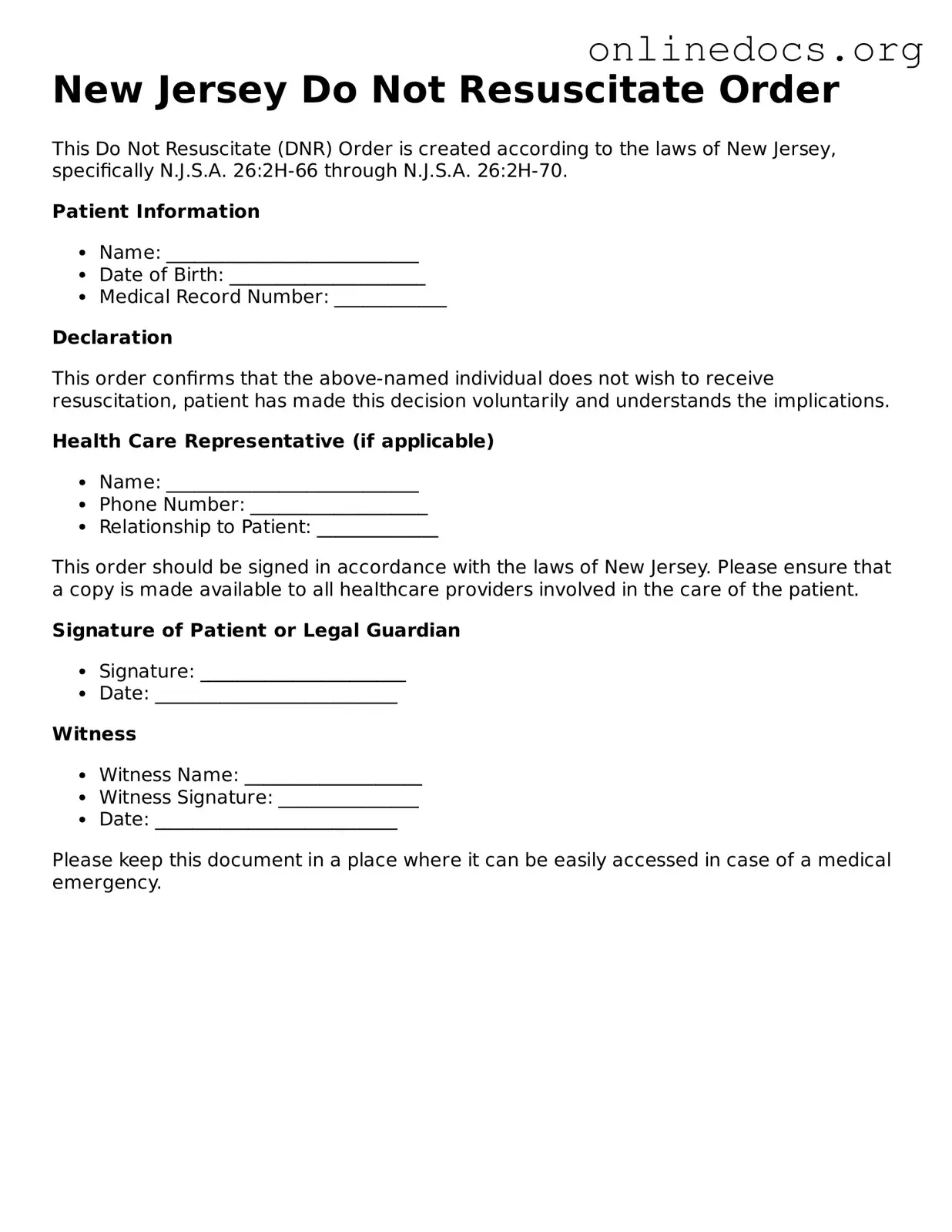The New Jersey Do Not Resuscitate (DNR) Order form shares similarities with the Advance Directive. An Advance Directive is a legal document that outlines a person’s preferences for medical treatment in case they become unable to communicate their wishes. Both documents empower individuals to make choices about their healthcare, ensuring that their desires are respected even when they cannot voice them. The DNR specifically focuses on the refusal of resuscitation efforts, while the Advance Directive encompasses a broader range of medical decisions, including the use of life-sustaining treatments and end-of-life care options.
Another document akin to the DNR Order is the Physician Orders for Life-Sustaining Treatment (POLST). The POLST form translates a patient's preferences regarding life-sustaining treatments into actionable medical orders. Like the DNR, it is designed for individuals with serious health conditions. The POLST provides clear guidance for healthcare providers, ensuring that patients receive care aligned with their wishes. Both documents aim to facilitate communication between patients and healthcare professionals, focusing on end-of-life care and respecting patient autonomy.
For those looking to verify employment status efficiently, utilizing the Employment Verification form can significantly aid in the hiring process. This essential document allows employers to confirm crucial details about job candidates, ensuring a robust evaluation of their professional credentials. You can conveniently access the Employment Verification form by following this link.
The Living Will is another document that bears resemblance to the DNR Order. A Living Will allows individuals to specify their wishes regarding medical treatment in the event of terminal illness or incapacitation. While the DNR focuses specifically on resuscitation efforts, the Living Will covers a wider array of treatment preferences. Both documents serve to communicate a person’s healthcare choices, providing clarity for family members and healthcare providers during critical moments.
Healthcare Power of Attorney (POA) is also similar to the DNR Order. A POA designates an individual to make healthcare decisions on behalf of another person if they are unable to do so. While the DNR provides specific instructions regarding resuscitation, the POA allows for broader decision-making authority. Both documents emphasize the importance of respecting a person’s wishes and ensuring that their healthcare preferences are honored, even in challenging circumstances.
The Medical Order for Life-Sustaining Treatment (MOLST) form is comparable to the DNR Order as well. Like the POLST, the MOLST is designed for patients with serious illnesses and provides specific medical orders regarding life-sustaining treatments. Both documents aim to ensure that medical interventions align with the patient’s values and preferences. They serve as vital tools for healthcare providers, facilitating discussions about end-of-life care and ensuring that patients receive the appropriate level of treatment based on their wishes.
Another document that aligns with the DNR Order is the Do Not Hospitalize (DNH) Order. This order specifically instructs healthcare providers not to transfer a patient to a hospital for treatment. Similar to the DNR, the DNH reflects the patient's wishes regarding the level of care they desire in a medical emergency. Both documents prioritize patient autonomy and aim to minimize unnecessary interventions that may not align with the individual’s values or preferences.
The Comfort Care Order is also similar to the DNR Order. This document emphasizes the provision of comfort measures rather than aggressive medical interventions. While the DNR focuses on avoiding resuscitation, the Comfort Care Order ensures that patients receive supportive care to enhance their quality of life. Both documents advocate for a compassionate approach to end-of-life care, prioritizing the patient’s comfort and dignity.
Finally, the End-of-Life Care Plan shares similarities with the DNR Order. This comprehensive document outlines a patient’s preferences for all aspects of care at the end of life, including pain management, emotional support, and spiritual considerations. While the DNR specifically addresses resuscitation efforts, the End-of-Life Care Plan encompasses a holistic view of the patient’s desires. Both documents aim to ensure that individuals receive care that aligns with their values and preferences during their final days.
